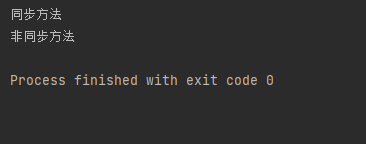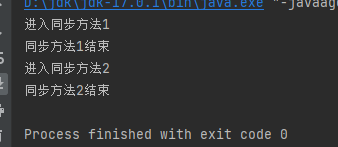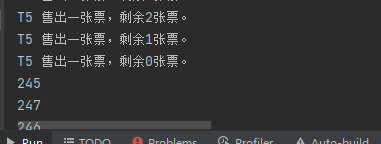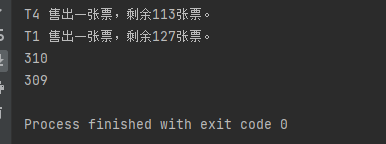高价值Java多线程面试题分析
问题一
A线程正在执行一个对象中的同步方法,B线程是否可以同时执行同一个对象中的非同步方法?
可以,两个线程运行所需资源不同,不需要抢占。
案例一、
package duoxiancheng2;
/**
* @author yeqv
* @program A2
* @Classname Ms1
* @Date 2022/2/7 19:08
* @Email w16638771062@163.com
*/
public class Ms1 {
//A线程正在执行一个对象中的同步方法,B线程是否可以同时执行同一个对象中的非同步方法?
Object a = new Object();
public static void main(String[] args) {
var t = new Ms1();
new Thread(() -> t.a1()).start();//A线程
new Thread(() -> t.a2()).start();//B线程
}
void a1() {
synchronized (a) {
System.out.println("同步方法");
}
}
void a2() {
System.out.println("非同步方法");
}
}
运行结果:

问题二
同上,B线程是否可以同时执行同一个对象中的另一个同步方法?
不可以,两个线程执行需要一个共同资源,共同资源加了同步锁,同一时刻只能一个线程占用。
案例二、
package duoxiancheng2;
import java.util.concurrent.TimeUnit;
/**
* @author yeqv
* @program A2
* @Classname Ms2
* @Date 2022/2/7 19:25
* @Email w16638771062@163.com
*/
public class Ms2 {
//同上,B线程是否可以同时执行同一个对象中的另一个同步方法?
Object a = new Object();
public static void main(String[] args) {
var t = new Ms2();
new Thread(() -> t.a1()).start();//A线程
new Thread(() -> t.a2()).start();//B线程
}
void a1() {
synchronized (a) {
System.out.println("进入同步方法1");
try {
TimeUnit.SECONDS.sleep(10);
} catch (InterruptedException e) {
e.printStackTrace();
}
System.out.println("同步方法1结束");
}
}
void a2() {
synchronized (a) {
System.out.println("进入同步方法2");
try {
TimeUnit.SECONDS.sleep(10);
} catch (InterruptedException e) {
e.printStackTrace();
}
System.out.println("同步方法2结束");
}
}
}
运行结果:
线程A先运行,占用资源。

等线程A运行完释放资源后,线程B才可以进入执行

线程B执行完

问题三
线程抛出异常会释放锁吗?
会,线程出现异常抛出后立刻释放资源。
案例三、
package duoxiancheng2;
import java.util.concurrent.TimeUnit;
/**
* @author yeqv
* @program A2
* @Classname Ms3
* @Date 2022/2/7 19:41
* @Email w16638771062@163.com
*/
public class Ms3 {
//线程抛出异常会释放锁吗?
Object a = new Object();
public static void main(String[] args) {
var t = new Ms3();
new Thread(() -> t.a1()).start();//A线程
new Thread(() -> t.a2()).start();//B线程
}
void a1() {
int c = 3;
int b;
synchronized (a) {
System.out.println("进入同步方法1");
try {
b = c / 0;
System.out.println(b);
TimeUnit.SECONDS.sleep(10);
} catch (InterruptedException e) {
e.printStackTrace();
}
System.out.println("同步方法1结束");
}
}
void a2() {
synchronized (a) {
System.out.println("进入同步方法2");
try {
TimeUnit.SECONDS.sleep(10);
} catch (InterruptedException e) {
e.printStackTrace();
}
System.out.println("同步方法2结束");
}
}
}
结果: 方法一出现异常,立刻释放资源。线程二开始执行

问题四
写一个程序,证明AtomicInteger类比synchronized更高效
synchronized更高效
案例一
package duoxiancheng2;
import java.util.concurrent.atomic.AtomicInteger;
/**
* @author yeqv
* @program A2
* @Classname Ms4
* @Date 2022/2/7 20:04
* @Email w16638771062@163.com
*/
public class Ms4 {
AtomicInteger n = new AtomicInteger(10000);
int num = 10000;
public static void main(String[] args) {
var t = new Ms4();
new Thread(t::minus, "T1").start();
new Thread(t::minus, "T2").start();
new Thread(t::minus, "T3").start();
new Thread(t::minus, "T4").start();
new Thread(t::minus, "T5").start();
new Thread(t::minus, "T6").start();
new Thread(t::minus, "T7").start();
new Thread(t::minus, "T8").start();
}
void minus() {
var a = System.currentTimeMillis();
while (true) {
/* if (n.get() > 0) {
n.decrementAndGet();
System.out.printf("%s 售出一张票,剩余%d张票。 %n", Thread.currentThread().getName(), n.get());
} else {
break;
}*/
synchronized (this) {
if (num > 0) {
num--;
System.out.printf("%s 售出一张票,剩余%d张票。 %n", Thread.currentThread().getName(), num);
} else {
break;
}
}
}
var b = System.currentTimeMillis();
System.out.println(b - a);
}
}
synchronized结果:

AtomicInteger结果:

问题五
写一个程序证明AtomXXX类的多个方法并不构成原子性
package demo16;
import java.util.ArrayList;
import java.util.List;
import java.util.concurrent.atomic.AtomicInteger;
/**
* 写一个程序证明AtomXXX类的多个方法并不构成原子性
*/
public class T {
AtomicInteger count = new AtomicInteger(0);
void m() {
for (int i = 0; i < 10000; i++) {
if (count.get() < 100 && count.get() >= 0) { //如果未加锁,之间还会有其他线程插进来
count.incrementAndGet();
}
}
}
public static void main(String[] args) {
T t = new T();
List<Thread> threads = new ArrayList<>();
for (int i = 0; i < 10; i++) {
threads.add(new Thread(t::m, "thread" + i));
}
threads.forEach(Thread::start);
threads.forEach((o) -> {
try {
//join()方法阻塞调用此方法的线程,直到线程t完成,此线程再继续。通常用于在main()主线程内,等待其它线程完成再结束main()主线程。
o.join(); //相当于在main线程中同步o线程,o执行完了,main线程才有执行的机会
} catch (InterruptedException e) {
e.printStackTrace();
}
});
System.out.println(t.count);
}
}
问题六
写一个程序,在main线程中启动100个线程,100个线程完成后,主线程打印“完成”
package cn.thread;
import java.util.concurrent.CountDownLatch;
/**
* 写一个程序,在main线程中启动100个线程,100个线程完成后,主线程打印“完成”
*
* @author webrx [webrx@126.com]
* @version 1.0
* @since 16
*/
public class T12 {
public static void main(String[] args) {
CountDownLatch latch = new CountDownLatch(100);
for (int i = 0; i < 100; i++) {
new Thread(() -> {
String tn = Thread.currentThread().getName();
System.out.printf("%s : 开始执行...%n", tn);
System.out.printf("%s : 执行完成,程序结束。%n", tn);
latch.countDown();
}, "T" + i).start();
}
try {
latch.await();
} catch (InterruptedException e) {
e.printStackTrace();
}
System.out.println("---------------------------------------");
System.out.println("100个线程执行完了。");
String tn = Thread.currentThread().getName();
System.out.printf("%s : 执行完成,程序结束。%n", tn);
}
}
到此这篇关于高价值Java多线程面试题分析的文章就介绍到这了,更多相关Java 多线程内容请搜索猪先飞以前的文章或继续浏览下面的相关文章希望大家以后多多支持猪先飞!
原文出处:https://blog.csdn.net/weixin_50843918/article/details/122813
相关文章
- 这篇文章主要介绍了如何利用java语言实现经典《复杂迷宫》游戏,文中采用了swing技术进行了界面化处理,感兴趣的小伙伴可以动手试一试...2022-02-01
C# WinForm多线程解决界面卡死问题的完美解决方案,使用BeginInvoke
问题描述:当我们的界面需要在程序运行中不断更新数据时,当一个textbox的数据需要变化时,为了让程序执行中不出现界面卡死的现像,最好的方法就是多线程来解决一个主线程来创建界...2020-06-24java 运行报错has been compiled by a more recent version of the Java Runtime
java 运行报错has been compiled by a more recent version of the Java Runtime (class file version 54.0)...2021-04-01- 这篇文章主要介绍了在java中获取List集合中最大的日期时间操作,具有很好的参考价值,希望对大家有所帮助。一起跟随小编过来看看吧...2020-08-15
- 这篇文章主要介绍了教你怎么用Java获取国家法定节假日,文中有非常详细的代码示例,对正在学习java的小伙伴们有非常好的帮助,需要的朋友可以参考下...2021-04-23
- 这篇文章主要介绍了Java如何发起http请求的实现,文中通过示例代码介绍的非常详细,对大家的学习或者工作具有一定的参考学习价值,需要的朋友们下面随着小编来一起学习学习吧...2021-03-31
- 说起C#和Java这两门语言(语法,数据类型 等),个人以为,大概有90%以上的相似,甚至可以认为几乎一样。但是在工作中,我也发现了一些细微的差别...2020-06-25
- 这篇文章主要介绍了解决Java处理HTTP请求超时的问题,具有很好的参考价值,希望对大家有所帮助。一起跟随小编过来看看吧...2021-03-29
- 这篇文章主要介绍了c# 多线程处理多个数据的方法,帮助大家更好的理解和学习使用c#,感兴趣的朋友可以了解下...2021-03-31
- 这篇文章主要介绍了java 判断两个时间段是否重叠的案例,具有很好的参考价值,希望对大家有所帮助。一起跟随小编过来看看吧...2020-08-15
- 这篇文章主要介绍了超简洁java实现双色球若干注随机号码生成(实例代码),本文通过实例代码给大家介绍的非常详细,对大家的学习或工作具有一定的参考借鉴价值,需要的朋友可以参考下...2021-04-02
- 这篇文章主要介绍了Java生成随机姓名、性别和年龄的实现示例,文中通过示例代码介绍的非常详细,对大家的学习或者工作具有一定的参考学习价值,需要的朋友们下面随着小编来一起学习学习吧...2020-10-01
java 画pdf用itext调整表格宽度、自定义各个列宽的方法
这篇文章主要介绍了java 画pdf用itext调整表格宽度、自定义各个列宽的方法,具有很好的参考价值,希望对大家有所帮助。一起跟随小编过来看看吧...2021-01-31- 这篇文章主要介绍了C#基于委托实现多线程之间操作的方法,实例分析了C#的委托机制与多线程交互操作的相关技巧,具有一定参考借鉴价值,需要的朋友可以参考下...2020-06-25
- 这篇文章主要介绍了java正则表达式判断前端参数修改表中另一个字段的值,需要的朋友可以参考下...2021-05-07
Java使用ScriptEngine动态执行代码(附Java几种动态执行代码比较)
这篇文章主要介绍了Java使用ScriptEngine动态执行代码,并且分享Java几种动态执行代码比较,需要的朋友可以参考下...2021-04-15- 这篇文章主要介绍了Java开发实现人机猜拳游戏,文中示例代码介绍的非常详细,具有一定的参考价值,感兴趣的小伙伴们可以参考一下...2020-08-03
- 这篇文章主要介绍了C#多线程中的异常处理操作,涉及C#多线程及异常的捕获、处理等相关操作技巧,需要的朋友可以参考下...2020-06-25
- 这篇文章主要介绍了Java List集合返回值去掉中括号('[ ]')的操作,具有很好的参考价值,希望对大家有所帮助。一起跟随小编过来看看吧...2020-08-29
- 这篇文章主要介绍了C#中异步和多线程的相关资料,帮助大家更好的理解和学习c#,感兴趣的朋友可以了解下...2021-01-16
